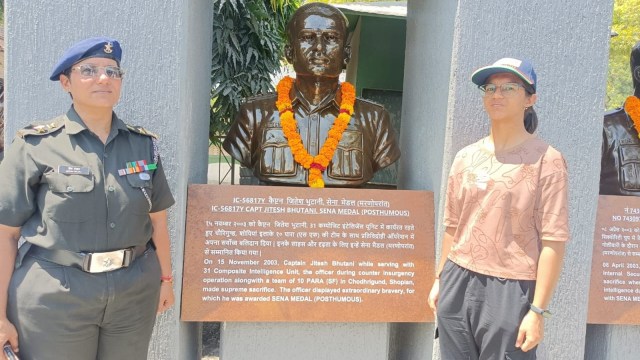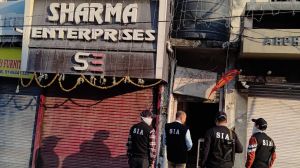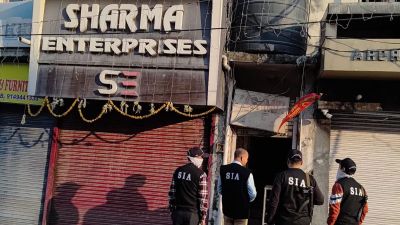Click here to join Express Pune WhatsApp channel and get a curated list of our stories
From combat to Covid, sacrifices of Military Intelligence officers now find place at Satark Heroes Park in Pune
It features a Wall of Valour, showcasing busts of 40 martyred soldiers from 1962 to 2020, and includes a cemented platform inscribed with the Military Intelligence Corps Geet.
 Leena Bajaj, wife of martyred Captain Jitesh Bhutani, with her daughter. (Express Photo)
Leena Bajaj, wife of martyred Captain Jitesh Bhutani, with her daughter. (Express Photo)
Sepoy Bikash Senchuwa was prepared with all his military belongings on January 6, 2005, after receiving a transfer letter to another location from Dibrugarh, Assam.
Coincidentally, Major Mukesh Chaurasia took him along for an operation where a villager had received an extortion note from the ULFA, stating that two militants would come for ransom. While they went in civilian attire to counter the insurgency, they were attacked and killed by the militants.
His and many other such stories were shared during the inaugural event of India’s first Satark Heroes Park, dedicated to 40 martyred soldiers of the Military Intelligence Corps at Wanowrie, Pune on Saturday.
The park was constructed and developed by Roadway Solutions India Infrastructure Limited in collaboration with the Military Intelligence Training School and Depot (MINTSD). It features a Wall of Valour, showcasing busts of 40 martyred soldiers from 1962 to 2020, and includes a cemented platform inscribed with the Military Intelligence Corps Geet.
 Ganesh Chaurasia and Meera Chaurasia, parents of Major Mukesh Chaurasia, while introducing Sepoy Bikash Senchuwa, Mukesh’s junior. (Express Photo)
Ganesh Chaurasia and Meera Chaurasia, parents of Major Mukesh Chaurasia, while introducing Sepoy Bikash Senchuwa, Mukesh’s junior. (Express Photo)
Standing in front of Senchuwa’s bust, Ganesh Mandal Chaurasia (83), a retired railway official from Munger district in Bihar, introduced the story of his son, Major Mukesh Chaurasia, who was posted in the Eastern Command Liaison Unit in Assam. Both Chaurasia and his junior, Senchuwa, were posted in the same unit and died in 2005.
Meera Chaurasia, a gazetted principal in a Bihar school, recalled her son’s early enthusiasm for the Army. “He already knew what he wanted to do and started preparing for the Army while he was still in school. Major became gis nickname when he cleared the NDA exam after the age of 17,” she said.
Similar emotions were echoed by Madhu Tirupathi, son of Captain Veluswamy Tirupathi, who was posted in Nagaland. Although Madhu was just seven-years-old when he lost his father, he recalled that before moving to Nagaland, his father had received a transfer order to Pune. “He cancelled the order and chose to stay in the field in Nagaland because he didn’t want to work in an office,” said Madhu.
 Madhu Tirupathi, son of Captain Veluswamy Tirupathi (Express Photo)
Madhu Tirupathi, son of Captain Veluswamy Tirupathi (Express Photo)
Pointing to the bust of havildar Kuriyan V T, Madhu said, “They were ‘buddies’ who always went on ambush operations together. But in April 2003, they went alone on a mission…After two days, their bodies were found mutilated. I returned home from school to find a crowd gathered at my house.”
Tirupathi and Kuriyan were serving in Nagaland for the Internal Security Group under Operation Orchid. They sacrificed their lives during an attack by Naga militants and were posthumously awarded the Sena Medal for their bravery.
Sunita Mehta, wife of Brigadier Ravi Datt Mehta, was voluntarily working alongside her husband in Kabul, Afghanistan, in 2008 when he made the ultimate sacrifice. Brigadier Mehta was killed in a suicide bombing at the Indian Embassy in Kabul on July 7, 2008, while serving as India’s Defence Attaché. “Kabul was a very disturbed area, and terrorists attacked their vehicle…When the vehicle reached the embassy gate, he took the full impact himself. If the explosive-laden vehicle had entered the compound, the entire embassy would have been destroyed,” she said.
 Sunita Mehta, wife of late Brigadier RD Mehta. (File Photo)
Sunita Mehta, wife of late Brigadier RD Mehta. (File Photo)
Sunita, a volunteer at Kabul University, was serving with the Government of India’s permission. Brigadier Mehta had served in the Army for 32 years and had been in Kabul for five months when the attack occurred. He was posthumously awarded the Kirti Chakra, the nation’s second-highest peacetime gallantry award. He is survived by his wife, son Udit Mehta (an IAF officer), and daughter Bhavya Mehta.
In another row of busts stood Leena Bajaj, wearing an Indian Army uniform, honoring her husband, Captain Jitesh Bhutani, who was killed during an anti-insurgency operation on November 15, 2003, in Shopian, near Srinagar. “I feel like I’m an extension of him,” said Bajaj, who now serves in the Indian Army’s Bombay Engineering Group (BEG) as an education officer. Before joining the Army in 2005, Bajaj was a faculty member at Allahabad University. She married Bhutani in 2002.
Bajaj recalled how Colonel Arvind Thakur, Bhutani’s commanding officer, encouraged her to join the Indian Army as an education officer. “He said that rather than serving in the civilian sector as an educationist, you should be in the Indian Army and serve there,” she said.
 Palak and her mother, Suman, standing in front of Subedar Rakesh Kumar’s bust. (Express Photo)
Palak and her mother, Suman, standing in front of Subedar Rakesh Kumar’s bust. (Express Photo)
Among the martyrs, subedar Rakesh Kumar was one of the most recent, having sacrificed his life during Covid-19 pandemic on October 14, 2020, while serving with HQ 39 Mountain Division, Northern Command, during Operation Snow Leopard in Ladakh. He had served in the Indian Army for 26 years. His daughter, Palak Kumar, who recently cleared the NEET exam, credited her success to her father’s encouragement and positive outlook towards life. “My father was always optimistic and handled everything with a positive attitude,” she said.
Palak’s mother Suman shared that they are from Kangra district in Himachal Pradesh. “It had been eight months since he had been posted there, and we were waiting for him to return home due to the pandemic.”
The event was inaugurated by Ameet Gadhoke, MD of Roadway Solutions India Infrastructure Ltd., and Lieutenant General PK Chahal, Commandant of MINTSD.
Click here to join Express Pune WhatsApp channel and get a curated list of our stories








